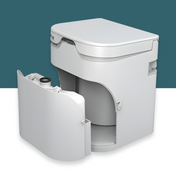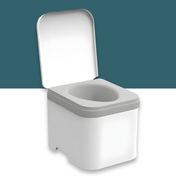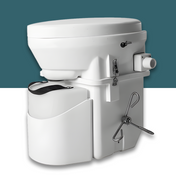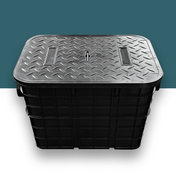Ever thought about what it would feel like to have your morning cuppa, knowing the water didn’t come from a tap, but from your own setup, collected and cleaned by you?
That’s the kind of self-sufficiency many Australians are now working towards. And for those just getting started with off-grid living, sorting out your water supply is often the first major step.
This guide will walk you through the most practical water sources for off-grid homes, how to store your water safely, and what to think about to keep things running smoothly over time.
Just starting out? Take a look at our Water Systems 101 Guide—a beginner-friendly breakdown of key terms and concepts to help you get your bearings before you build.
Table of Contents
- Traditional Sources of Water for Off-Grid Living
- Comparing Off-Grid Water Sources: Pros & Cons
- Off-Grid Water Storage: Keeping Your Supply Flowing
- Take the Next Step Toward Water Independence
Traditional Sources of Water for Off-Grid Living
One of the first questions many people ask when thinking about living off the grid is: “Where will my water come from?”
The good news is, Australians have been using smart, independent ways to collect water for generations. Depending on your property and lifestyle, there are several great options to explore, each with its own benefits.
Let’s take a look at the most common ones you might come across.
Water Bores
If you’re living on a rural block, one reliable way to get water is by drilling a bore. This means digging down to reach natural underground water, often stored in something called an aquifer.
Bores can provide a steady supply of water for everything from showers and drinking to watering veggie patches and keeping animals hydrated.
Before setting one up, here’s what to keep in mind:
- Is there water underground? You’ll need to get the land checked to see if there’s enough water under the surface to make a bore worthwhile.
- Is the water safe to use? Some underground water contains minerals or bacteria. You’ll want to test it and add a simple filter or UV purifier if needed.
- How will you pump the water up? Many people use solar-powered pumps to keep things off-grid and energy-efficient.
- Do I need permission? It’s a good idea to speak to your local council to check on permits or water rights before you start drilling.

Rainwater Harvesting
Rainwater harvesting involves collecting and storing rainwater from your roof, turning every downpour into a valuable resource. This eco-friendly and cost-effective method reduces reliance on other water sources and can provide water for household use, gardening, or even drinking with proper filtration.
Here’s what makes it work well:
- A clean roof and guttering help keep the water quality high.
- First flush diverters are small add-ons that send the first bit of dirty rainwater (with leaves and dust) away from your tank.
- Storage tanks come in lots of sizes and materials. Look for food-grade ones to keep your water safe.
- Filters and purifiers can turn rainwater into safe drinking water, especially if you're using it for kitchen or bathroom use.

These tanks collect what falls on your roof and store it for when you need it—perfect for drinking, garden use, and cutting back on mains water.
Ponds
If you’ve got a bit of land and want something more natural, building a pond could be an option.
Ponds can collect and hold rainwater or runoff, and are handy for watering the garden, raising fish, or just creating a peaceful space for wildlife.
A few things to think about:
- Choose a spot that naturally holds water (or gets runoff after rain).
- Make sure the soil type will hold the water without too much seepage.
- Keep an eye on water quality so algae or mozzies don’t take over.

Springs
Some properties, especially in more remote areas, might have a natural spring—water that flows to the surface all on its own.
If you’ve got one, that’s a real win. Springs can supply clean, fresh water year-round with very little setup.
But you’ll still need to:
- Check the flow to make sure it’s enough for your needs.
- Keep the area clean and protected from animals or runoff.
- Look into the rules around using spring water in your area.
Finding the right water source depends on your land, your setup, and what feels practical for your everyday needs. Some rely on rain tanks, others dig bores, and some are lucky enough to have a spring or a good pond spot.
Whatever your starting point, a bit of planning goes a long way. With the right setup, you can have a steady, reliable water supply that works for you—and helps make off-grid living feel a whole lot easier.

Comparing Off-Grid Water Sources: Pros & Cons

Off-Grid Water Storage: Keeping Your Supply Flowing
Once you’ve worked out how to collect water, the next big step is figuring out where to keep it. Good storage is what helps you get through dry spells, make the most of rainy days, and keep things running smoothly around the home.
Let’s run through a few popular ways to store water off the grid.
Rain Barrels
If you’re new to collecting rainwater, rain barrels are one of the easiest ways to begin. They sit neatly under your roof’s downpipe and catch the water that runs off when it rains.
They’re a great low-cost option for watering the garden, cleaning, or topping up water for pets or animals. And with a basic filter or UV unit, they can even be used for drinking in some setups.
Top Benefits of Rain Barrels:
- Easy to set up, even if you’ve never done anything like this before.
- Budget-friendly way to try out rainwater harvesting.
- Good for watering plants, cleaning tools, or washing down gear.
- Helps reduce your need for town water.
A few tips to get the most from your barrel:
- Give it a clean every so often to keep things fresh.
- Add a mesh screen to stop mozzies, leaves, or debris from getting in.
- Place your tap or spout low on the barrel so it drains properly.

Rainwater Tanks
If you’re ready for a more permanent setup, rainwater tanks are a solid option. They come in all shapes and sizes—some hold a few thousand litres, others tens of thousands. That means you can collect enough to run your entire home, even during dry months.
In most cases, water flows from your roof and gutters straight into the tank. Add a filter and UV treatment, and you’ve got clean, safe water for drinking, cooking, showering, laundry, and more.
What makes them a great choice:
- Stores a lot more water than barrels—great for full household use.
- Keeps you covered when there’s little or no rain for a while.
- Can fully support all your water needs, indoors and outdoors.
What to consider before buying:
- Tanks come in different materials like plastic, concrete, or stainless steel.
- You’ll want to hook them up to your guttering for best results.
- A filter and UV setup help make the water safe to drink.
Modular Storage Tank Systems
If you’ve got bigger plans or if your water needs might grow over time, modular tank systems are worth a look. These are tanks you can link together or expand as needed. They're ideal if you’re storing water from more than one source, like rain, bore, or even surface runoff.
You can also pair them with solar or pressure pumps, and even set up hot water storage using solar heaters.
Common types include:
- Polyethylene (poly) tanks: lightweight, durable, and easy to set up
- Fibreglass tanks: great for transport or remote areas
- Stainless steel tanks: long-lasting and hygienic
Extra features to think about:
- Can be hooked up to pressure pumps or gravity-fed systems.
- Can be tailored to suit off-grid or hybrid setups.
- Some can include hot water storage, too.

Finding the Right Storage for Your Setup
You might start small with a single barrel by the back shed, or go straight into setting up a full tank beside the house. Either way, choosing the right way to store your water can make a big difference to how easy life off the grid feels.
It’s not about getting it perfect from day one—it’s about having a setup that works for your space, your needs, and the way you live. Over time, as things grow or change, your system can grow too.
Take the Next Step Toward Water Independence
Living off the grid isn’t about going without—it’s about finding better ways to manage the things that matter most. And water is right at the top of that list.
Setting up your own water system means you’re less affected by restrictions, rising bills, or unpredictable weather. It’s about peace of mind, knowing you’ve got a supply you can count on—and the freedom that comes with it.
At Eco Off Grid, we’re here to make that easier. Maybe you’re starting with a single tank. Maybe you’re working toward a full off-grid setup. Whatever the plan looks like, we’ve got the gear and guidance to help you make it happen.
Ready to get started?
Check out our range of:
- Water Tanks made for Aussie conditions
- Water Filtration Systems for safe drinking water
- Water and Bore Pumps to move water where you need it
If you’re not sure what suits your setup best, we’re happy to help you work it out.





